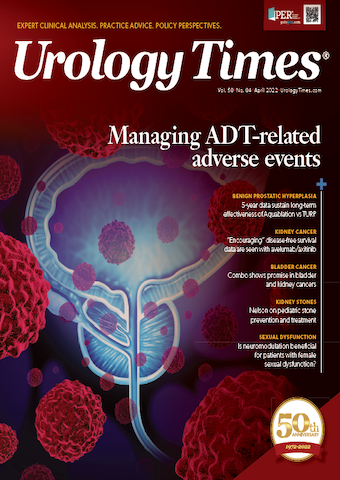Publication
Article
Urology Times Journal
Findings support safety, feasibility of partial-gland treatment
Author(s):
"If adequate cancer control can be achieved by focal or partial-gland treatment, then the favorable adverse event profile could make this a preferred option for a number of men with localized intermediate-risk (and possibly selected high-risk) prostate cancer," writes Badar M. Mian, MD.
Badar M. Mian, MD

The advent of enhanced imaging and detection of localized prostate cancer through targeted biopsy has improved the feasibility and safety of targeted or focal therapy for men with prostate cancer. Once thought to be an option only suitable for men with low-risk prostate cancer, focal therapy is being used as a viable option for those with clinically significant prostate cancer, with the primary goal of avoiding or minimizing the treatment-related adverse effects associated with whole-gland treatment (radical prostatectomy or radiation therapy).
A recent article by Reddy et al reports updated results on patients with localized prostate cancer in the high-intensity focused ultrasound (HIFU) Evaluation and Assessment of Treatment (HEAT) registry from the United Kingdom over the past 15 years, where focal HIFU has been used as a standard alternative to whole-gland treatment.1
A total of 1379 patients from 13 UK centers were reported in the HEAT registry between November 2005 and July 2020. Men with prostate cancer whose Gleason score was 6 to 9 and with a clinical stage up to T3bN0M0 were offered focal therapy using the Sonablate. Patients were classified as having D’Amico low-, intermediate-, or high-risk disease. Only patients with MRI-visible lesions, and without any high-volume (6 mm) Gleason score 6 or any-volume Gleason score 7 disease in the untreated gland, were considered suitable candidates for focal ablation.
The primary outcome was failure-free survival (FFS), defined as no evidence of cancer requiring whole-gland salvage treatment or third focal therapy treatment, any systemic treatment, development of metastases, or prostate cancer–specific death. Secondary outcomes included adverse events and complications classified by the Clavien-Dindo system, as well as other oncologic outcomes.
Follow-up included prostate-specific antigen (PSA) test and multiparametric MRI at variable intervals, as well as per protocol and for-cause repeat prostate biopsy. If clinically significant cancer (defined as Gleason score ≥ 3 + 4) was identified as occurring in field (residual disease) or out of field (de novo or progressive disease), patients were offered either repeat focal treatment or radical radiotherapy, or radical prostatectomy.
The median follow-up was 32 months for the entire cohort, and 82 months for the 325 (23%) patients with at least 5 years’ follow-up. The median age of patients was 66 years and median PSA level was 6.9 (4.9-9.4) ng/mL. Seventy-nine percent of patients (1093/1379) had grade group 2 or higher (19%, grade group 1; 78%, grade group 2).
The FFS at 7 years was 69%, and 7-year FFS for intermediate- and high-risk cancers was 68% and 65% (P = .3), respectively. Significant differences in FFS were noted at 7 years between grade group 2 and 3 (P = .05). Of the 609 patients who underwent repeat prostate biopsy, recurrent/residual cancer was reported in 403 (66%). Of these, 314 patients demonstrated residual/recurrent Gleason score 7 prostate cancer during their follow-up period.
Retreatment-free survival at 7 years was 43%; in other words, more than half of patients required some additional treatment. There was statistically significant difference in retreatment-free survival between D’Amico risk groups (P < .0001). Overall, 132 patients underwent salvage whole-gland treatment or systemic treatment, including 53 salvage radical prostatectomy and 39 salvage radiotherapy. Salvage treatment-free survival at 7 years was 75%, with 3 patients developing metastases and 1 of whom subsequently died from prostate cancer.
Postoperative complications were noted in 83 of 1379 (6.0%) patients after focal therapy. The rate of complications in those with a Clavien-Dindo score greater than 2 was 0.5% (7/1379), and most complications were self-limiting, without hospital admission or intervention.
This study represents the largest cohort of partial-gland treatment for localized prostate cancer and is notable for utilizing MRI and transperineal biopsy for cancer diagnosis, patient selection, and treatment planning. Overall, 69% FFS was noted at 7 years after primary focal HIFU, with over 20% of patients requiring additional ablations. The study demonstrates the safety and feasibility of partial-gland ablation, along with acceptable cancer control, although any statements regarding oncological efficacy would be premature considering the median follow-up for the entire cohort was only 2.7 years.
Partial-gland treatment for prostate cancer has been studied for the past 15 to 20 years using various energy sources and ablative devices. Despite the early adoption of focal therapy in the United Kingdom, requiring 15 years to accumulate 1379 cases from 13 centers (about 7 cases/year/center) highlights the slow uptake of this modality for carefully selected patients only. Patient selection is further evident from the lack of differences in the outcomes between the intermediate- and high-risk cohorts, which seems to defy tumor biology, further suggesting the presence of favorable features in the high-risk cohort.
There are inherent differences in the definition of success following partial-gland or focal ablation and whole-gland treatment (surgery or radiation). For example, retreatment with another ablative procedure for tumor persistence or recurrence is not viewed as treatment failure, whereas any subsequent therapy after whole-gland treatment is considered failure of initial treatment. A microscopic positive margin or pg of detectable PSA is classified as residual disease after radical prostatectomy, whereas repeat biopsy showing obvious residual disease following focal ablation is viewed as an opportunity for further ablation without being classified as salvage treatment.
This, along with short follow-up, precludes oncologic efficacy comparison between focal ablative therapy and whole-gland treatment. If adequate cancer control can be achieved by focal or partial-gland treatment, then the favorable adverse event profile could make this a preferred option for a number of men with localized intermediate-risk (and possibly selected high-risk) prostate cancer. Until the ongoing randomized controlled trials with adequate follow-up can provide data on comparative effectiveness, physicians will have to rely on single-cohort studies demonstrating the feasibility and safety of focal treatment to guide patient counseling and clinical decision-making.
Reference
1. Reddy D, Peters M, Shah TT, van Son M, Tanaka MB, Huber PM, et al. Cancer control outcomes following focal therapy using high-intensity focused ultrasound in 1379 men with nonmetastatic prostate cancer: a multi-institute 15-year experience. Eur Urol. 2022;S0302-2838(22)00006-9. doi:10.1016/j.eururo.2022.01.005

Newsletter
Stay current with the latest urology news and practice-changing insights — sign up now for the essential updates every urologist needs.































